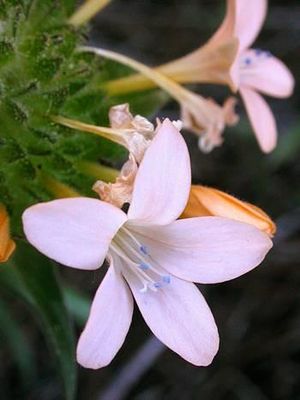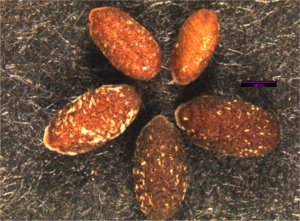Difference between revisions of "Collomia grandiflora"
(→Description) (Tag: VisualEditor) |
|||
| Line 24: | Line 24: | ||
=== Description === | === Description === | ||
| − | + | Robust, tap-rooted annual up to 1 m. tall, from simple and unbranched to often with many axillary branches terminating in flower clusters. | |
| − | Leaves | + | Leaves numerous, lanceolate, alternate, sessile and entire, 2-8 cm. long and 3-15 mm. wide. |
| − | Flowers | + | Flowers in tight clusters, terminating the stem and branches; calyx tube of uniform, papery texture, the 5 lobes up to 4 mm. long; triangular, pointed, herbaceous; corolla tubular, salmon-colored, 2-3 cm. long, the 5 lobes 5-10 mm. long; filaments of unequal length, inserted below the sinuses of the corolla; style 3-parted; ovary superior. |
| − | + | Fruits capsule with 3, 1-seeded carpels.<ref name=":0">WTU Herbarium, Burke Museum, & University of Washington. Retrieved from https://biology.burke.washington.edu/herbarium/imagecollection/taxon.php?Taxon=Collomia%20grandiflora</ref> | |
=== Bloom Period === | === Bloom Period === | ||
| − | + | May-August<ref name=":0" /> | |
=== Distribution === | === Distribution === | ||
| − | + | Widely distributed on both sides of the Cascades crest in Washington; British Columbia to California, east to Montana, Wyoming, and Colorado.<ref name=":0" /> | |
=== Habitat === | === Habitat === | ||
| − | Open, moist to rather dry areas, low to moderate elevations in the mountains. Moist to drier soil – not heat-resistant and requires cool nights. | + | Open, moist to rather dry areas, low to moderate elevations in the mountains.<ref name=":0" /> Moist to drier soil – not heat-resistant and requires cool nights. |
=== Uses === | === Uses === | ||
| − | Infusion of roots or of leaves and stalks taken by Okanogan-Colville as a laxative; Infusion of roots taken by Okanogan-Colville for high fevers; | + | Infusion of roots or of leaves and stalks taken by Okanogan-Colville as a laxative; Infusion of roots taken by Okanogan-Colville for high fevers; Use of leaves by Paiute and others as a protective covering for filled berry containers. |
=== Propagation === | === Propagation === | ||
| Line 82: | Line 82: | ||
===References=== | ===References=== | ||
| + | <references /> | ||
Revision as of 09:37, 29 March 2021
- Scientific Name: Collomia grandiflora
- Family: Polemoniaceae
- Common Names: large-flowered collomia, large-flower mountain-trumpet
- Codon: COLGRA
Contents
Taxonomy
| Scientific classification | |
|---|---|
| Kingdom: | Plantae |
| Subkingdom: | Viridiplantae |
| Phylum: | Tracheophyta |
| Subphylum: | Spermatophytina |
| Class: | Magnoliopsida |
| Subclass: | Asteranae |
| Order: | Ericales |
| Family: | Polemoniaceae |
| Genus: | Collomia Nutt. |
| Species: | Collomia grandiflora Douglas ex. Lindl |
Description
Robust, tap-rooted annual up to 1 m. tall, from simple and unbranched to often with many axillary branches terminating in flower clusters.
Leaves numerous, lanceolate, alternate, sessile and entire, 2-8 cm. long and 3-15 mm. wide.
Flowers in tight clusters, terminating the stem and branches; calyx tube of uniform, papery texture, the 5 lobes up to 4 mm. long; triangular, pointed, herbaceous; corolla tubular, salmon-colored, 2-3 cm. long, the 5 lobes 5-10 mm. long; filaments of unequal length, inserted below the sinuses of the corolla; style 3-parted; ovary superior.
Fruits capsule with 3, 1-seeded carpels.[2]
Bloom Period
May-August[2]
Distribution
Widely distributed on both sides of the Cascades crest in Washington; British Columbia to California, east to Montana, Wyoming, and Colorado.[2]
Habitat
Open, moist to rather dry areas, low to moderate elevations in the mountains.[2] Moist to drier soil – not heat-resistant and requires cool nights.
Uses
Infusion of roots or of leaves and stalks taken by Okanogan-Colville as a laxative; Infusion of roots taken by Okanogan-Colville for high fevers; Use of leaves by Paiute and others as a protective covering for filled berry containers.
Propagation
Sow seeds in both the fall and early spring for the maximum season of flowering.
Seed
Abbreviation: COGRX
Seed sample from: 2011
Average measurement: 3 x 1.5 x 1.1
Measurement range: L: 2.75 - 3.1 W: 1.2 x 1.7 D: 0.9 x 1.3
Features
Shape: One end of seed is slightly more rounded than other. This is the hilium end. One side of seed has longitudinal sulcus that does not reach the hilium or opposite apex.
Color: Hilium indistinct. Entire seed surface mostly uniform in color. Seed is brown with some white spots that are flakey looking.
Surface:Entire seed is very bumpy, sometimes slightly ridged. When wet, seed coat forms many clear, mucilaginous threads.
Could be confused with: Gilia capitata
Latitudinal cross section: elliptical ![]()
Longitudinal cross section: elliptical ![]()
Basic Explanations and Assumptions:
The dimensions for the seeds are length x width x depth. The location of the hilum is used as the base of the seed, and the length is measured from hilum to the opposite apex. Where a style is present, the length is measured from the hilum to the bottom of the style. Width is measured at a right angle to the length at the widest part. Depth is measured at a right angle to the intersection of height and width lines.
Measurements included are the mean average for each measurement of ten separate seeds.
All measurements in millimeters unless otherwise noted.
Photo Gallery
References
- ↑ Integrated Taxonomic Information System. Retrieved from https://www.itis.gov/servlet/SingleRpt/SingleRpt?search_topic=TSN&search_value=31037
- ↑ 2.0 2.1 2.2 2.3 WTU Herbarium, Burke Museum, & University of Washington. Retrieved from https://biology.burke.washington.edu/herbarium/imagecollection/taxon.php?Taxon=Collomia%20grandiflora





